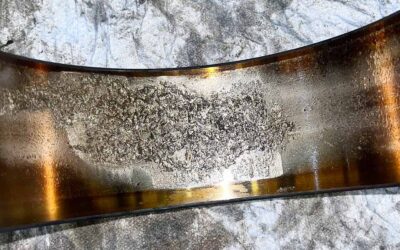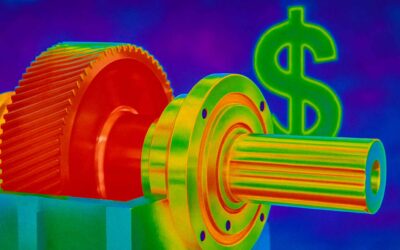Have you and your team included threaded-fastener management in your proactive maintenance and plant reliability goals? You should. And sooner than later. The reasons for doing so are clear.
Poor threaded-fastener connections create vibration in mechanical systems. Vibration reduces the life of components by applying unintended forces. Looseness is damaging in electrical connections. As much as half of all electrical problems in electric motors are fastener-related. So mechanical and electrical fasteners should be a priority for your reliability management strategy.
Detecting Threaded Fastener Looseness
Plant personnel can detect fastener looseness with vibration analysis by looking for increased vibration at 1X running speed and harmonics at multiples of running speed, frequently exhibiting half harmonics. On the time waveform, you’ll often see flatheads on the sinusoid.
Thermographic analysis usually reveals poor electrical connections, given that a poor connection reduces conductivity and generates heat as a byproduct. However, ultrasonic analysis can reveal tracking and arc-spark emissions associated with the accumulation of static electricity.
Threaded Fastener Basics
Effective fastening aims to achieve a sufficient level of clamping force. Clamping force is achieved by adequately tensioning threaded fasteners to leverage the elastic properties of metal.
When tightened, fasteners elastically deform to create tension between the threads (much like a spring). Some metals can elastically tolerate more force than others. Generally, the higher the SAE grade for a bolt, the higher the tension it can handle and provide a more significant clamping force potential.
It’s important to note that over-tensioning a fastener beyond its elastic limit, i.e., the limit below which the threads will “spring” back into their usual place upon loosening, will permanently damage the fastener (a phenomenon called “plastic deformation”).
Think of over-tensioning and pushing a fastener beyond its elastic limit this way: If you pull on it, a spring returns to its normal state. That is unless you pull too hard. In that case, the spring will not return to its normal state.
Hooke’s Law defines the elastic limit of materials from an engineering perspective. If you want to learn more, an Internet search on Hooke’s Law will produce plenty of helpful information.
Threaded Fastener Best Practices
Consider the following best practices when developing a fastener program at your plant:
- Select bolts carefully. Fasteners must be appropriately sized and fabricated from the appropriate material. SAE grade 5 (ISO 8.8) bolts have much higher elastic tension limits than SAE grade 2 (ISO 4.6). SAE grade 8 (ISO 10.9) bolts have even higher tension limits than SAE 5 (ISO 8.8). You should eliminate fasteners below SAE 5 (ISO 8.8). Use SAE grade 8 (ISO 10.9) or even the unofficial SAE grade 9 (ISO 12.9) for high-vibration applications.
- Always lubricate fasteners, preferably using a purpose-formulated fastener lubricant.
- Always use an appropriately sized and calibrated torque wrench. Employ hydraulic torque wrenches for very large fasteners.
- Use only correctly sized, hardened, flat designs if washers are required. Do not use spring-type lock washers for fasteners that are 3/8″ (M8) or larger since they would flatten out and reduce the effective clamping surface area.
- Ensure even distribution of the clamp load by fastening in a crossing pattern.
- Tighten to 1/3, 2/3, then the final torque required using the crossing pattern described above. Perform a final-pass torque check before concluding the job.
- Make sure electrical connection points are free of debris or oil, which can compromise electrical conductivity.
- Perform periodic torque checks, particularly for high-vibration machines like shaker tables. Employ an ultrasonic bolt-stretch meter for critical applications, which measures tension more directly.
- Avoid excessive shimming and carefully inspect foundation grouting. No amount of precision fastening can overcome an inherently poor foundation.
- Incorporate fastener and fastening specifications in all work plans. Refrain from making your craftspeople guess.
- Regularly monitor for mechanical looseness using vibration analysis. Use infrared thermography to identify poor electrical connections.
In many plants, the maintenance instructions provided with work orders can be vague. However, details on properly tightening threaded fasteners are essential in avoiding looseness-related vibration in rotating equipment and leakage in piping flanges.
Assuming work-order instructions specify the proper size and quality of necessary threaded fasteners, they rarely detail the appropriate torque value, fastener-lubrication requirements, and the sequence to tighten such fasteners. All three of these elements are required to achieve controlled tightening. Let’s address each of them here, one at a time.
Torque Value: The Foundation of Fastener Security
Torque relates to the force applied to the threaded fastener. The imperial unit is pound-feet (lb-f) or pound-inches (lb-in). The SI unit is the Newton meter (Nm). One lb-f = about 1.36 Nm, and one lb-f = 12 lb-in.
If you apply one pound of force one inch from the rotational center of the threaded fastener, you increase the force by a factor of 12 if you increase the length of your wrench to 12 inches or one foot.
Remember: the longer the wrench, the greater the force. That’s why a pipe placed on the end of the wrench is sometimes called a “cheater bar.” The force can also be increased with a geared torque multiplier.
Torque is so crucial because it’s necessary to achieve enough tension on the threads of a fastener to secure it and, thus, prevent it from loosening—particularly in the presence of vibration.
The threads of a fastener behave like a spring: They’re elastic. Regarding tightening procedures, we want to achieve enough force to secure the fastener but not so much that we exceed the elastic limit of the fastener.
For bolts that will be reused, we typically aim to tension to about 75% of the fastener’s proof load, or elastic limit.
For single-use fasteners (torque-to-yield bolts) such as engine head bolts, we typically torque to 90-95% of the proof load. The size of the fastener, the grade of the fastener, and the thread type (fine or coarse) determine the appropriate torque value. All maintenance instructions must include these values in the fit, tolerance, quantity, and quality details.
Fastener Lubrication: Preventing 90% Force Loss
While we apply torque and measure the force with a torque wrench, the goal is to achieve tension on the threads—and torque doesn’t always equate to tension.
The formula for calculating required torque includes the “K” factor to account for friction. Most torque charts include values for lubricated and non-lubricated fasteners. (Forget the non-lubricated value. It’s guesswork, at best.)
As much as 90% of the torque applied is lost to friction.
Frictional losses starve the threads of the tension they need to create a securely fastened joint. About half of the frictional force is lost in the threads, and the other half is lost on the nut face. (NOTE: it’s best to keep a bolt static and turn the nut when tightening a fastener.)
Work instructions must direct the maintainer to apply lubricant to the threads AND nut face in light of the frictional force loss in the threads and on the nut face. Machine oil is acceptable.
Extreme-pressure (EP) gear oil is better. A good molybdenum disulfide thread lubricant or nickel anti-seize is best for controlling tension and creating a strong, tight, fastened joint. (NOTE: It’s a good practice to clean and de-bur the threads before applying the lubricant.)
Fastening Sequence: Mastering the Critical Pattern
Most fastened joints involve multiple fasteners. It’s essential for maintenance-work instructions to specify the sequence in which such fasteners are tightened to prevent possible soft-foot issues in equipment and leaks in pipe flanges.
First, we must specify the geometrical sequence. Tighten the fasteners using a geometrical crisscross pattern to apply the force evenly.
Then, we must specify the torque sequence, which should include:
- Wrench/spanner tight, following the geometrical sequence.
- One-third torque value, following the geometrical sequence.
- Two-thirds torque, following the geometrical sequence.
- Final torque, following the geometrical sequence.
- Final pass, following the geometrical sequence.
The ROI From Precision: Eliminating Vibration and Leaks
Incorporating details on torque values, fastener-lubrication requirements, and required-fastening sequence in all corrective- and preventive maintenance instructions will help ensure that personnel build precision into your site’s fastened joints. Once that takes hold, sit back, relax, and watch as vibration and leak problems begin to evaporate.
Initially published in The RAM Review.










